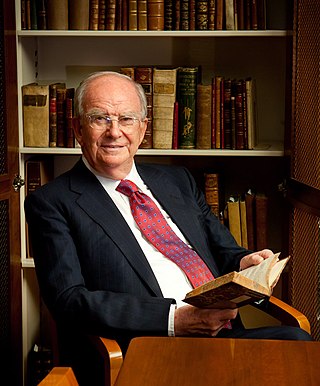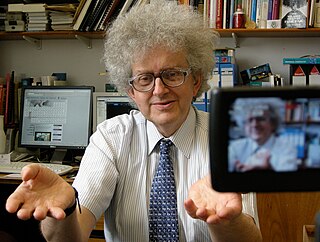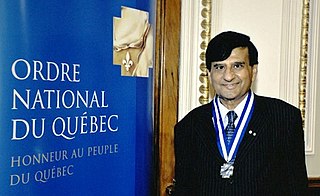Related Research Articles

Richard Laurence Millington Synge was a British biochemist, and shared the 1952 Nobel Prize in Chemistry for the invention of partition chromatography with Archer Martin.

Archer John Porter Martin was a British chemist who shared the 1952 Nobel Prize in Chemistry for the invention of partition chromatography with Richard Synge.

Raghunath Anant Mashelkar, also known as Ramesh Mashelkar, is an Indian Chemical Engineer, born in a village named Marcel in Goa and brought up in Maharashtra.
Craig Jon Hawker is an Australian-born chemist. His research has focused on the interface between organic and polymer chemistry, with emphasis on the design, synthesis, and application of well-defined macromolecular structures in biotechnology, microelectronics, and surface science. Hawker holds more than 45 U.S. patents, and he has co-authored over 300 papers in the areas of nanotechnology, materials science, and chemistry. He was listed as one of the top 100 most cited chemists worldwide over the decade 1992–2002, and again in 2000–2010.
Stephen B. H. Kent is a professor at the University of Chicago. While professor at the Scripps Research Institute in the early 1990s he pioneered modern ligation methods for the total chemical synthesis of proteins. He was the inventor of native chemical ligation together with his student Philip Dawson. His laboratory experimentally demonstrated the principle that chemical synthesis of a protein's polypeptide chain using mirror-image amino acids after folding results in a mirror-image protein molecule which, if an enzyme, will catalyze a chemical reaction with mirror-image stereospecificity. At the University of Chicago Kent and his junior colleagues pioneered the elucidation of protein structures by quasi-racemic & racemic crystallography.

Kendall Newcomb Houk is a Distinguished Research Professor in Organic Chemistry at the University of California, Los Angeles. His research group studies organic, organometallic, and biological reactions using the tools of computational chemistry. This work involves quantum mechanical calculations, often with density functional theory, and molecular dynamics, either quantum dynamics for small systems or force fields such as AMBER, for solution and protein simulations.

Sir John Meurig Thomas, also known as JMT, was a Welsh scientist, educator, university administrator, and historian of science primarily known for his work on heterogeneous catalysis, solid-state chemistry, and surface and materials science.

Sir Martyn Poliakoff is a British chemist known for his work on green chemistry and for being the main presenter on the popular YouTube channel Periodic Videos. The core subjects of his academic work are supercritical fluids, infrared spectroscopy and lasers. He is a research professor in chemistry at the University of Nottingham. As well as carrying out research at the University of Nottingham, he is a lecturer, teaching a number of modules including green chemistry.

Ashok K. Vijh, is an Indian born Canadian chemist. He was born in Punjab but moved to Canada in 1962.

Michael Lawrence KleinNAS is Laura H. Carnell Professor of Science and director of the Institute for Computational Molecular Science in the college of science and technology at Temple University in Philadelphia, US. He was previously the Hepburn Professor of Physical Science in the Center for Molecular Modeling at the University of Pennsylvania.

Anthony Ledwith was a British chemist.

Jnanendra Nath Mukherjee CBE, FRSC was an Indian colloid chemist.
Colin Llewellyn Raston is a Professor of Chemistry of Flinders University in Adelaide, South Australia and the Premier's Professorial Fellow in Clean Technology. In 2015, he was awarded an Ig Nobel Prize in "for inventing a chemical recipe to partially un-boil an egg". In 2016, Raston was made an Officer of the Order of Australia for his services to science.

Sukh Dev FNA, FASc was an Indian organic chemist, academic, researcher and writer, known for his contributions in the development of guggulsterone, a plant-derived steroid used as a therapeutic and nutritional agent. He conducted advanced research in biomedical science and natural products chemistry and held 55 patents for his findings.
Stephen G. Weber is a professor of chemistry and clinical translational science at the University of Pittsburgh. He researches analytical separations theory and its application, and has developed "green" techniques for molecular recognition and microextractions. He is particularly interested in the identification of peptides and dipeptides, and their effects on neurochemistry. He has received a number of awards, including the 2016 Dal Nogare Award for "contributions to the fundamental understanding of the chromatographic process".

Ganapati Dadasaheb Yadav is an Indian chemical engineer, inventor and academic, known for his research on nanomaterials, gas absorption with chemical reaction and phase transfer catalysis. He served as the vice chancellor of the Institute of Chemical Technology, Mumbai from 2009 until November 2019. He is currently the Emeritus Professor of Eminence at ICT Mumbai.

Daniel Wayne Armstrong is an American chemist who specializes in separation science, chiral molecular recognition, bioanalytic analysis, mass spectrometry and colloid chemistry. He is the Robert A. Welch Distinguished Professor at the University of Texas at Arlington. He has authored ~ 750 publications including 35 book chapters, a book, and holds over 35 patents on separation technologies. He was an associate editor for the prestigious American Chemical Society journal Analytical Chemistry. He is a fellow of the American Chemical Society, Royal Chemical Society (UK), and the National Academy of Inventors. Armstrong has given over 560 invited seminars worldwide at international conferences, universities and corporations. His research and patents formed the basis for two companies: Advanced Separation Technologies, Inc; which was acquires by Sigma-Aldrich Corporation in 2006 and AZYP, LLC in Arlington, TX. His published work has been cited over 50,000 times and his h-index is 115. He is believed to have mentored more graduate level analytical chemists than any living scientist.

Milos Vratislav Novotny is an American chemist, currently the Distinguished Professor Emeritus and Director of the Novotny Glycoscience Laboratory and the Institute for Pheromone Research at Indiana University, and also a published author. Milos Novotny received his Bachelor of Science from the University of Brno, Czechoslovakia in 1962. In 1965, Novotny received his Ph.D. at the University of Brno. Novotny also holds honorary doctorates from Uppsala University, Masaryk University and Charles University, and he has been a major figure in analytical separation methods. Novotny was recognized for the development of PAGE Polyacrylamide Gel-filled Capillaries for Capillary Electrophoresis in 1993. In his years of work dedicated to analytical chemistry he has earned a reputation for being especially innovative in the field and has contributed a great deal to several analytical separation methods. Most notably, Milos has worked a great deal with microcolumn separation techniques of liquid chromatography, supercritical fluid chromatography, and capillary electrophoresis. Additionally, he is highly acclaimed for his research in proteomics and glycoanalysis and for identifying the first mammalian pheromones.
John Henderson Knox FRS was a Professor of Physical Chemistry at the University of Edinburgh and is considered a distinguished contributor to the fields of reaction kinetics and chromatography.
John Michael Ramsey is an American analytical chemist at the University of North Carolina at Chapel Hill. He currently holds the position of Minnie N. Goldby Distinguished Professor of Chemistry. His current research with the university focuses on microscale and nanoscale devices such as microchip electrospray, microscale Ion trap mass spectrometers, and microfluidic point of care devices. He is ranked #2 in the "Giants of Nano" field on The Analytical Scientist Power List.
References
- ↑ Briddell (16 January 2013). "Profile - Dr. Milton Hearn". ACS. Retrieved 4 August 2015.
- 1 2 "Finalist Dr. Milton Hearn" (PDF). LCGC. LCGC. Retrieved 4 August 2015.
- ↑ "Professor wins prestigious American Chemical Society Award in Chromatography". Monash University. 20 August 2014. Retrieved 4 August 2015.
- ↑ "Professor Milton Thomas HEARN". Australian Honours Search Facility. Retrieved 10 October 2024.